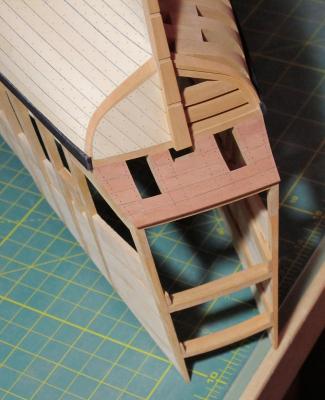-
Posts
13,306 -
Joined
-
Last visited
Content Type
Profiles
Forums
Gallery
Events
Everything posted by druxey
-
It's tricky, trying to keep in mind everything above the deck you are working on aligning properly later. I'm glad that you caught that earlier rather than too late!
- 1,215 replies
-
- sloop
- kingfisher
-
(and 1 more)
Tagged with:
-

FLOQUIL PAINT IS HISTORY
druxey replied to kurtvd19's topic in Painting, finishing and weathering products and techniques
re: the letter from Testors, last paragraph: "increased customer intimacy"? What kind of horrible PR-speak is that???? I don't want to go there with you, Kristin Schiro! -
Just starting a deck's worth of ledges, so I'm looking enviously at yours! Your model is coming along beautifully, Toni.
- 1,449 replies
-
Mica is a naturally occurring material, Randy. Rockhounds' shops will have it. It comes in layered sheets that are slightly tinted. You peel the layers apart. The individual layers are very thin and also somewhat flexible. As it is a natural material, there are usually spots and flaws in it and you will need to select areas that are flawless. Cuts easily with sharp scissors. If the scissors are dull, the edges tend to crack and become opaque. That said, it's easy to work with if you are careful. In the old days, mica was also used in enclosed fireplaces as it is semi-transparent in thicker pieces and heat resistant. When I was young I recall 'Otto' stoves in England that had mica windows in the front-opening doors.
-
That is an interesting idea, Ian. I wish I'd heard of that years ago. I managed to go through a box of 100 microscope slide covers without making one successful piece of glazing! I am now using mica. That is easily cut to shape. It's what the old-time ship modelmakers used.
-

ancre Le Fleuron 1729 by rekon54 - 1:24
druxey replied to rekon54's topic in - Build logs for subjects built 1501 - 1750
Terrific work: definitely stupendo! -
My own take is that the cants did not cross the doorways, but I could be wrong. Nice going, Dan!
-

Echo by jml1083 - cross-section
druxey replied to jml1083's topic in - Build logs for subjects built 1751 - 1800
Truckin' right along there, Jim. Good stuff! -

Copper, bronze and brass. How to treat them.
druxey replied to Modeler12's topic in Metal Work, Soldering and Metal Fittings
Thank you, gentlemen, for this interesting and informative discussion! -
Those carlings line up very nicely, Toni. Well done! One can't finish a fully framed model in weeks or months, unfortunately.... Good things take time.
- 1,449 replies
-

Echo by oneslim - cross-section
druxey replied to oneslim's topic in - Build logs for subjects built 1751 - 1800
Ah! Contact cement is a very different beast from rubber cement. One can now get non-solvent based contact cement, I believe. Much safer and better for health and the environment. -
Well, Grant, it's your model and you have to be happy with how it looks. My opinion doesn't matter!
-
I agree that in model work that is the usual convention. However, in many real ships both the side and transom planks hooded into rabbets in the fashion piece (the curved timber that made the 'corner' of the stern). This was to avoid exposed end-grain, where moisture could wick in to the planks and start rot. I've done this the 'correct' way on a model and can state that it is a very tricky job! No wonder one doesn't see this on models.
-

Echo by oneslim - cross-section
druxey replied to oneslim's topic in - Build logs for subjects built 1751 - 1800
Bob: I use VM&P naphtha as rubber cement solvent, available from paint merchants. -
I agree with you, Kester, that this was sometimes done. Thanks for reminding me. However, on a model I would tone the blocks down from pure white anyway so that they would not jump out visually.
-
Regardless of the wood used, the shade should not be too pale. Models with white or pale blocks look very distracting: they look like a snowstorm in the rigging to my eye.
-

Echo by oneslim - cross-section
druxey replied to oneslim's topic in - Build logs for subjects built 1751 - 1800
Jim: once you've made a successful cast timber, you won't look back. Except, perhaps, unless you make two right-hand ones instead of a left and a right pair!
About us
Modelshipworld - Advancing Ship Modeling through Research
SSL Secured
Your security is important for us so this Website is SSL-Secured
NRG Mailing Address
Nautical Research Guild
237 South Lincoln Street
Westmont IL, 60559-1917
Model Ship World ® and the MSW logo are Registered Trademarks, and belong to the Nautical Research Guild (United States Patent and Trademark Office: No. 6,929,264 & No. 6,929,274, registered Dec. 20, 2022)
Helpful Links
About the NRG
If you enjoy building ship models that are historically accurate as well as beautiful, then The Nautical Research Guild (NRG) is just right for you.
The Guild is a non-profit educational organization whose mission is to “Advance Ship Modeling Through Research”. We provide support to our members in their efforts to raise the quality of their model ships.
The Nautical Research Guild has published our world-renowned quarterly magazine, The Nautical Research Journal, since 1955. The pages of the Journal are full of articles by accomplished ship modelers who show you how they create those exquisite details on their models, and by maritime historians who show you the correct details to build. The Journal is available in both print and digital editions. Go to the NRG web site (www.thenrg.org) to download a complimentary digital copy of the Journal. The NRG also publishes plan sets, books and compilations of back issues of the Journal and the former Ships in Scale and Model Ship Builder magazines.



